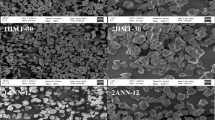Abstract
The impact of hydrothermal processing undergone by bread dough during baking on the degree of starch granule disruption, on leaching of soluble amylose, on water mobility, on firmness and on amylopectin retrogradation during staling has been investigated. Two heating rates during baking have been considered (4.67 and 6.31 °C/min) corresponding respectively to baking temperature of 220 and 240 °C. An increase in firmness and in the amount of retrogradated amylopectin accompanied by a decrease in freezable water has been observed during staling. Although a lower heating rate yielded in larger amount of retrogradated amylopectin retrogradation, it resulted in a lower firmness. Additionally, the amount of soluble amylose and the relaxation times of water measured by Nuclear Magnetic Resonance NMR (T20, T21 and T22) decreased during staling. It was demonstrated that the amount of soluble amylose was higher for bread crumb baked at lower heating rate, indicating that an increasing amount of amylose is leached outside the starch granules. This was corresponding to a greater amount of retrograded amylopectin during staling. Moreover, it was found that the degree of gelatinization differs locally in a same bread slice between the top, the centre and the bottom locations in the crumb. This was attributed to the differences in kinetics of heating, the availability of water during baking and the degree of starch granule disruption during baking. Based on first order kinetic model, it was found that staling kinetics were faster for samples baked at higher heating rate.







Similar content being viewed by others
References
AACC (1999a) AACC method 61–03: amylose content of milled rice. Approved Methods of the American Association of Cereal Chemists: 1-4
AACC (1999b) AACC method 74–09.1: Measurement of bread firmness by universal Testing machine. Approved methods of the American Association of Cereal Chemists: 1–4
Assifaoui A, Champion D, Chiotelli E, Verel A (2006) Characterization of water mobility in biscuit dough using a low-field 1H NMR technique. Carbohydr Polym 64:197–204
Chen PL, Long Z, Ruan R, Labuza TP (1997) Nuclear magnetic resonance studies of water mobility in bread during storage. LWT 30:178–183
Curti E, Bubici S, Carini E, Baroni S, Vittadini E (2011) Water molecular dynamics during staling by nuclear magnetic resonance. LWT Food Sci Technol 44:854–859
Davidou S, Le Meste M, Debever E, Bekaert D (1996) A contribution to the study of staling of white bread: effect of water and hydrocolloid. Food Hydrocoll 10:375–383
Eliasson AC (1985) Retrogradation of starch as measured by differential scanning calorimetry. In Hill, Munck (Eds.), New approaches to Researches on Cereal Carbohydrates Elsevier Science, Amsterdam
Engelsen SB, Jensen MK, Pedersen HT, Norgaard L, Munck L (2001) NMR-baking and multivariate prediction of instrumental texture parameters in bread. J Cereal Sci 33:59–69
Fessas D, Schiraldi A (1998) Texture and staling of wheat bread crumb: effects of water extractable proteins and 'pentosans'. Thermochimica Acta: 17-26
Giovanelli G, Peri C, Borri V (1997) Effects of baking temperature on crumb staling kinetics. Cereal Chem 74:710–714
Gray JA, Bemiller JN (2003) Bread staling : molecular basis and control. Compr Rev Food Sci Food Saf 2:1–21
Hallberg L, Chinachoti P (2002) A fresh perspective on staling: the significance of starch recrystallisation on the firming of bread. J Food Sci 67:1092–1096
Jacobs H, Mischenko N, Koch MHJ, Eerlingen RC, Delcour JA, Reynaers H (1998) Evaluation of the impact of annealing on gelatinisation at intermediate water content of wheat and potato starches: a differential scanning calorimetry and small angle X-ray scattering study. Carbohydr Res 306:1–10
Le Bail A, Boumali K, Jury V, Ben-Aissa F, Zuniga R (2009) Impact of baking kinetics on staling rate and mechanical properties of bread crumb and degazed bread crumb. J Cereal Sci 50:235–240
Le-Bail A, Agrane S, Queveau D (2011) Impact of the baking duration on bread staling kinetics. Food Biopro Technol. doi:10.1007/s11947-011-0634-3
Patel BK, Seetharaman K (2010) Effect of heating rate at different moisture contents on starch retrogradation and starch-water interactions during gelatinization. Starch 62:538–546
Patel BK, Waniska RD, Seetharaman K (2005) Impact of different baking processes on bread firmness and strach properties in breadcrumb. J Cereal Sci 42:173–184
Ribotta PD, Le Bail A (2007) Thermo-physical assessment of bread during staling. Lebensmittel-Wissenschaft und-Technologie 40:879–884
Rogers DE, Zeleznak KJ, Lai CS, Hoseney RC (1988) Effect of native lipids, shortening, and bread moisture on bread firming. Cereal Chem 65:398–401
Seetharaman K, Chinnapha N, Waniska RD, White P (2002) Changes in textural, pasting and thermal properties of wheat buns and tortillas during storage. J Cereal Sci 35:215–223
Vodovotz Y, Hallberg L, Chinachoti P (1996) Effect of aging and drying on thermomechanical properties of white bread as characterized by dynamical mechanical analysis (DMA) and differencial scanning calorimetry (DSC). Cereal Chem 73:264–270
Yi J, Kerr WL (2009) Combined effects of dough freezing and storage conditions on bread quality factors. J Food Eng 93:495–501
Yi J, Johnson JW, Kerr WL (2009) Properties of bread made from frozen dough containing waxy wheat flour. J Cereal Sci 50:364–369
Zeleznak KJ, Hoseney RC (1986) The role of water in retrogradation of wheat starch gels and bread crumb. Cereal Chem 63:407–411
Acknowledgments
This work was supported by the government of Tunisia (PhD grant of E. Besbes), the Scientific Council of Oniris (PhD grant support) and the University ‘Nantes, Angers, Le Mans’ (LUNAM). The authors acknowledge the collaboration of the University of Guelph, Department of Food Science, to carry out this research.
Author information
Authors and Affiliations
Corresponding author
Rights and permissions
About this article
Cite this article
Besbes, E., Le Bail, A. & Seetharaman, K. Impact of local hydrothermal treatment during bread baking on soluble amylose, firmness, amylopectin retrogradation and water mobility during bread staling. J Food Sci Technol 53, 304–314 (2016). https://doi.org/10.1007/s13197-015-1992-z
Revised:
Accepted:
Published:
Issue Date:
DOI: https://doi.org/10.1007/s13197-015-1992-z




